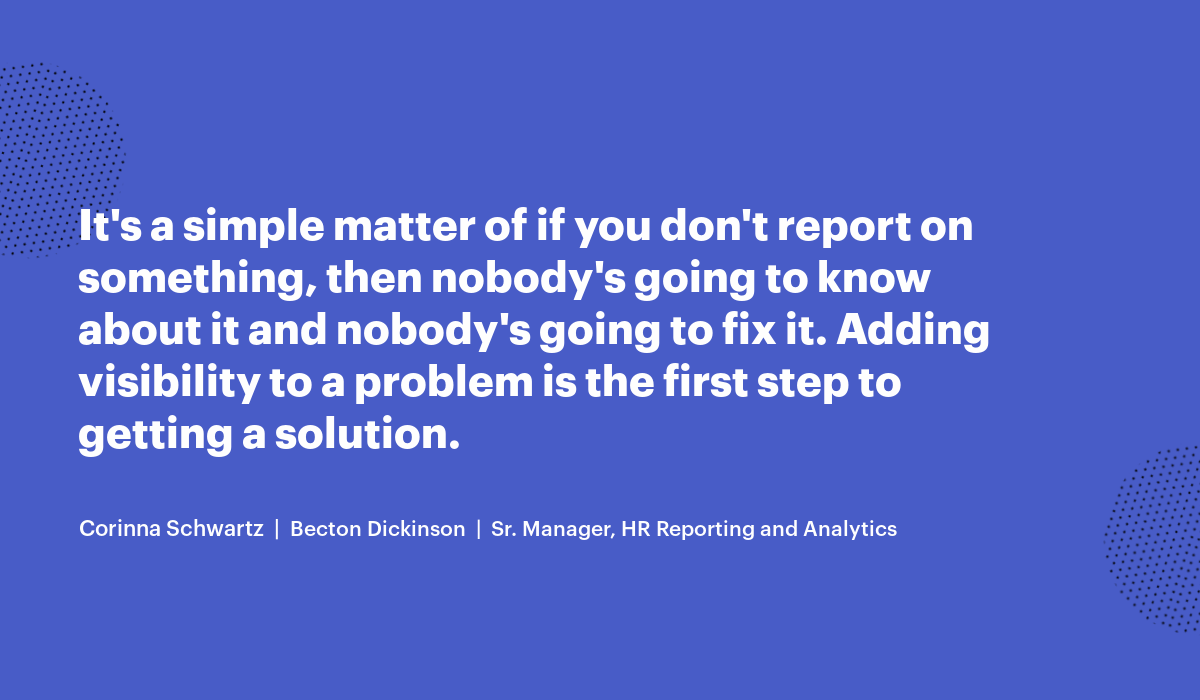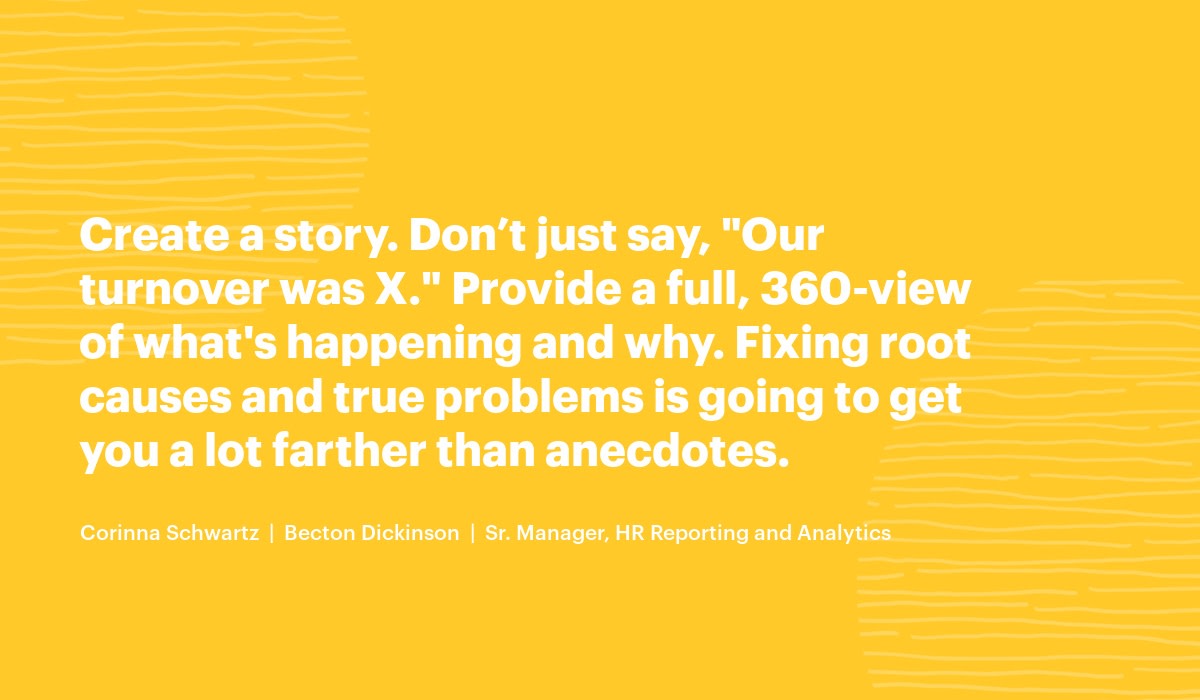How Becton Dickinson’s Corinna Schwartz Created an International Network of Visier Users
In this profile, we talk to Becton Dickinson's Corinna Schwartz on supporting a global workforce, influencing the C-Suite, and making connections.

The last 18 months proved that strong HR leadership is needed more than ever. In this profile series, we celebrate the HR Super Leaders that led their organizations through tough times by harnessing their HR superpowers—daring, vision, empathy, strategy, and connection—and proving that anything is possible when you put your people first. Learn more about the other HR Super Leaders and take our quiz to find out which one is yours!
Corinna Schwartz is a Senior Manager of HR Reporting and Analytics based in Texas for Becton Dickinson, a medical device manufacturer. If you have ever been swabbed for strep throat, chances are, they made the agar plate! After quadrupling in size the past ten years, the 90,000 employees and contingent workers are now spread across 65 countries. In this profile, we talk to Corinna about how her team supports global employees, what businesses can do to help working parents, and why visibility was key to cutting retention in half for a specific employee group.
Tell us about your role at Becton Dickinson. What does a typical day look like for you, Corinna?
I manage two teams, reporting and analytics. For reporting, it’s mostly requests—anyone in the company can ask for anything—and then we will either build a report or provide them the data. It’s also project work to support our annual cycles, or anytime anybody needs HR data in their project. The analytics team reports on the company’s HR key driver goals, identifying trends and areas of concern. If one of the numbers starts to fall below target, then we’ll work with that HRBP to try to identify the problem and bring it up.
I’ve been with the company for over 20 years, so I have a lot of knowledge and a long memory, so I’m often brought in to add expertise for HR data in general, or reporting in analytics in specific.
What led you to pursue a career in people analytics?
I was in hospitality management and that was fun when I was in my twenties, but after a while I was like, “I’m too old to work this late at night.” I wanted to get with a company where there was a future, and I went to BD and started actually in manufacturing. I then moved to procurement and relocated to Texas when they opened up the service center here, still in procurement as a team lead. And it got to the point where I realized that I like numbers, I like data, I like working with it, I like problem solving, I like understanding what’s happening and why. There was an opening in HR analytics, and I went with it. It’s been a real success for me and I’ve really enjoyed my time with it. It’s an interesting dataset, it’s ever-evolving, there’s so many pieces to it, and so many ways to look at it, and so much value it can bring.
You’ve seen your company grow about four times larger during your tenure, how do you continue to put the human in human resources?
We are very high touch still. Despite growing from 18,000 to 90,000 employees, and moving from 40 to 400 who are using Visier, we have been able to maintain relationships with a lot of these users. The people who are in there—we know them well.
But when they do reach out, you have to make sure that they’re learning from the experience and not relying on you all the time. That’s sometimes a little bit of a challenge. But overall, I think we’ve been very successful at trying to get our users self-sufficient and still feel that they have a support network.

BD is in 65 countries, how do you support a large number of users in so many time zones?
We were able to create a training guidebook that customers can access in Visier. It is a one-stop-shop of links—knowledge articles, Visier Academy, videos that we’ve made, documents that we’ve created. Now people can just go in there and find stuff. I was really proud of it when it came out.
We’ve also built monthly office hours into our support model. We schedule some really early in the morning so that our friends in Europe can join, and we schedule some in the evenings so our friends in Asia can join. Sometimes the users want an immediate answer, and that’s why we’ve tried to build a local support network of their local peers.
My dream, of course, is to have somebody on my team in every region at some point. But we’re not there yet.
How have you experienced people analytics’ impact on business success?
In our population of 89,000 employees, about 15,000 are not in Workday who work in manufacturing in Mexico, where there is a very different labor market.
For years, they had established a long history of bad turnover, like 70%. But nobody knew about it because nobody could see it. The workers obviously knew about it and were dealing with it everyday. But from a leadership perspective, the business or HR, neither really had any sense of how bad it was. When we were able to get those non-Workday employees into Visier, and add Mexico operations turnover to our key driver goals, the turnover rate in that area halved, to 35%.
Without visibility, no one’s going to fix it. As soon as somebody saw it, there was laser focus to get it fixed. It’s a simple matter of if you don’t report on something, then nobody’s going to know about it and nobody’s going to fix it. Adding visibility to a problem is the first step to getting a solution.
How do you think people analytics supports companies in creating a successful hybrid workforce?
My first thought is engagement—doing regular poll surveys and understanding expectations on hybrid working, working from home, or not working from home. And then analyzing that information to see if there’s a relationship between who’s happy, who’s not happy, and who’s leaving.
It’s using engagement data to understand where your people are and what’s important to them. Really I think the answer is that companies need to be creative and think outside the box. Maybe it’s childcare, maybe it’s work-life flexibility, but trying to find more ways to help working moms would be what I hope comes out of this.

How are you combatting the resignation wave?
I was just driving through town the other day and I’m like, “There’s the restaurant I used to go to, and it’s gone. There’s the nail salon I used to go to, and it’s empty.” Those employees have to go somewhere, where are they going to work?
At Becton Dickinson, we’ve spent the last few months preparing with our HR leadership. We’ve looked at what our problem areas are, where we need to focus our attention, and what we can do to mitigate it. The other aspect of this that I think is really interesting is the candidate pool. Once we recognized that everybody can be virtual, our candidate pool opens to the world. We don’t have to have somebody who can physically sit next to me on my team. Now we have the ability to get the right person, the right job, the right capabilities. That’s why one of the things we’re going to work on is how the virtual environment has expanded who we can hire. There’s some niche jobs that are really hard to find and data analytics is one of them.
Visier imagined five HR superpowers that guided leaders through the last 18 months. Which one do you most identify with?
I think connection is for me. I love talking to people. My favorite part of conversations with customers is when we show them how to do something and they’re like, “Oh, that was so easy. That’s fantastic.” And they just, they love it.
Also being able to say, “Oh, so-and-so in Kenya had the same problem that you’re having over here in Mexico. Here’s how we solved their problem, let’s see if that helps you.” I think a lot of the HR partners in other countries are very much like, “Oh, my country is unique and special,” and of course every country is unique and special. But I think there’s a lot of problems that solutions can be shared, even though there’s some slight nuances in legal structure and labor market differences. It doesn’t mean that solutions can’t be common just because countries are different.
Last question. How can people use people analytics to influence and support C-suite leaders?
Create a story. Don’t just say, “Our turnover was X.” Provide a full, 360-view of what’s happening and why. I think when you can do things like that, it disputes the anecdotal misconceptions. That’s one of the battles that we have long faced in HR data is, someone will get this idea in their head of, “There’s a problem here.” And it’ll be based on very anecdotal stories. Of course sometimes there are true problems there, but if you can say, “This is the facts,” then you can shut those down and focus on the true areas of concern so that you can better fix them. Because if you focus on the one-offs, you’re not going to see any improvement in the long term. Fixing root causes and true problems is going to get you a lot farther than anecdotes.
Meet the rest of our HR Super Leaders and find out your HR superpower, by visiting visier.com/hr-leaders


